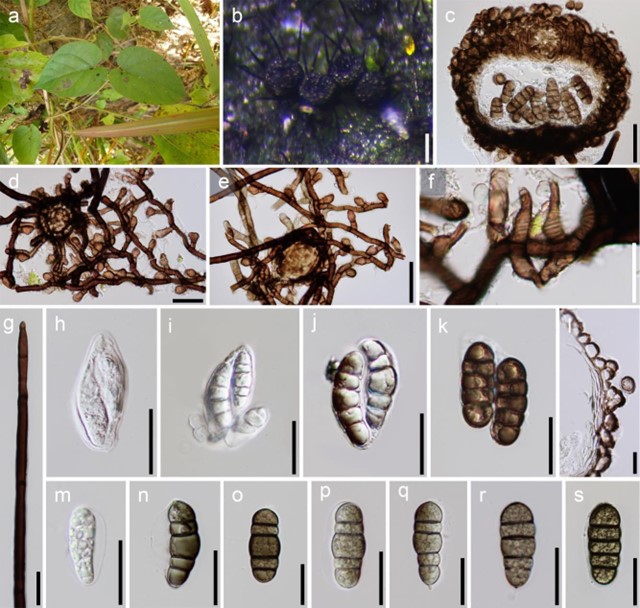Meliola telosmae Rehm, Philipp. J. Sci., C, Bot. 8: 392 (1913)
Index Fungorum number: IF 237666; MycoBank number: MB 237666; Facesoffungi number: FoF 05218
Colonies epiphyllous, scattered. Hyphae superficial, sub-straight to crooked, branching opposite at acute to wide angles, reticulate. Hyphal setae straight, up to 200 μm, tapering at the apex. Appressoria alternate to unilateral, straight to curved, antrorse, 2-celled, clavate to spathulate, 14–22 × 7–10 μm (x̅ = 17 × 8 µm, n = 20). Sexual morph: Ascomata superficial, globose to subglobose, dense, grouped, dark brown, up to 150 μm in diameter, composed of hyaline inner cell and dark brown outer wall with textura angularis, with a central ostiole and dark brown setae around the base. Asci 2–4-spored, unitunicate, ellipsoid to ovoid, ascus wall becomes thinner and asci without a certain shape at mature state. Ascospores 30–36 × 12–15 μm (x̅ = 33 × 13 µm, n = 10), 2–4-seriate, hyaline when young, brown or olive-brown when mature, cylindrical to ellipsoid, 4-septate, slightly constricted at septa, middle cell larger than others. Asexual morph: Phialides 13–18 × 5–7 μm (x̅ = 15 × 6 µm, n = 10), opposite to alternate, with few mixed with appressoria, ampulliform.
Material examined – Thailand, Nang Lae, Chaing Rai, on the living leaves of Telosma cordata (Apocynaceae), 4 January 2014, Saranyaphat Boonmee, MFLU 14-0003, reference specimen designated here.
GenBank Accession numbers – ITS-LSU: MK103389, SSU: MK103390.
Known distribution (based on molecular data) – China (Zhuang 2001), Thailand (this study).
Known hosts (based on molecular data) – Asclepiadaceae species, Dischidanthus urceolatus (Zhuang 2001), Telosma cordata (this study).
Notes – The only species of Meliolaceae found on the Telosma hosts is Meliola telosmae. The new collection matches all the morphological features given in the description of the reported species, except for the ascospore size. However, Meliola telosmae does not have any sequence data. Therefore, in the phylogenetic analysis, our new collection clusters with M. clerodendricola with 100%/1.00 bootstrap support (Fig. 65). There is 90% (547/607 nucleotide, 33/607 gaps) similarity in the ITS region between our isolate and M. clerodendricola, which does reach the threshold to be the same species as suggested by Jeewon & Hyde (2016). Morphologically, Meliola telosmae differs from M. clerodendricola in having dense colonies, longer setae (up to 200 μm vs up to 170 μm), and thinner ascospores (12–15 μm vs 10–13 μm). Therefore, we assign this new collection as a reference specimen of M. telosmae with sequence data.

Figure 1 – Meliola telosmae (Material examined – THAILAND, Nang Lae, Chiang Rai, on the living leaves of Telosma cordata (Apocynaceae), 4 January 2014, Saranyaphat Boonmee, MFLU 14-0003, reference specimen designated here). a The host plant. b Ascomata on leaf surface. c Cross section of ascoma. d, e Hyphae with appressoria. f Phialides. g Setae. h-k Asci from young to mature state. l Peridium. m-s Ascospores. Scale bars: b = 100 µm, c-e = 50 µm, f-s = 20 µm.
